Detailed Report on Organisation Structure and Culture in Public Sector
VerifiedAdded on 2020/11/12
|8
|2071
|406
Report
AI Summary
This report delves into the critical aspects of organisation structure and culture, examining different management styles within the public sector, with a specific focus on the National Health Service (NHS). The report investigates the impact of organisational behaviour, motivation, and reflection on workplace performance, highlighting the interconnectedness of these elements. It provides an overview of organisational behaviour, including organisational psychology and group dynamics. Furthermore, the report analyzes motivational theories, specifically Maslow's Hierarchy of Needs, and applies it to the NHS to assess advantages and disadvantages. The report concludes by emphasizing the significance of organisational culture, management approaches, and employee motivation in achieving organisational goals and maximizing employee potential. The report uses various sources to support the arguments and analysis.
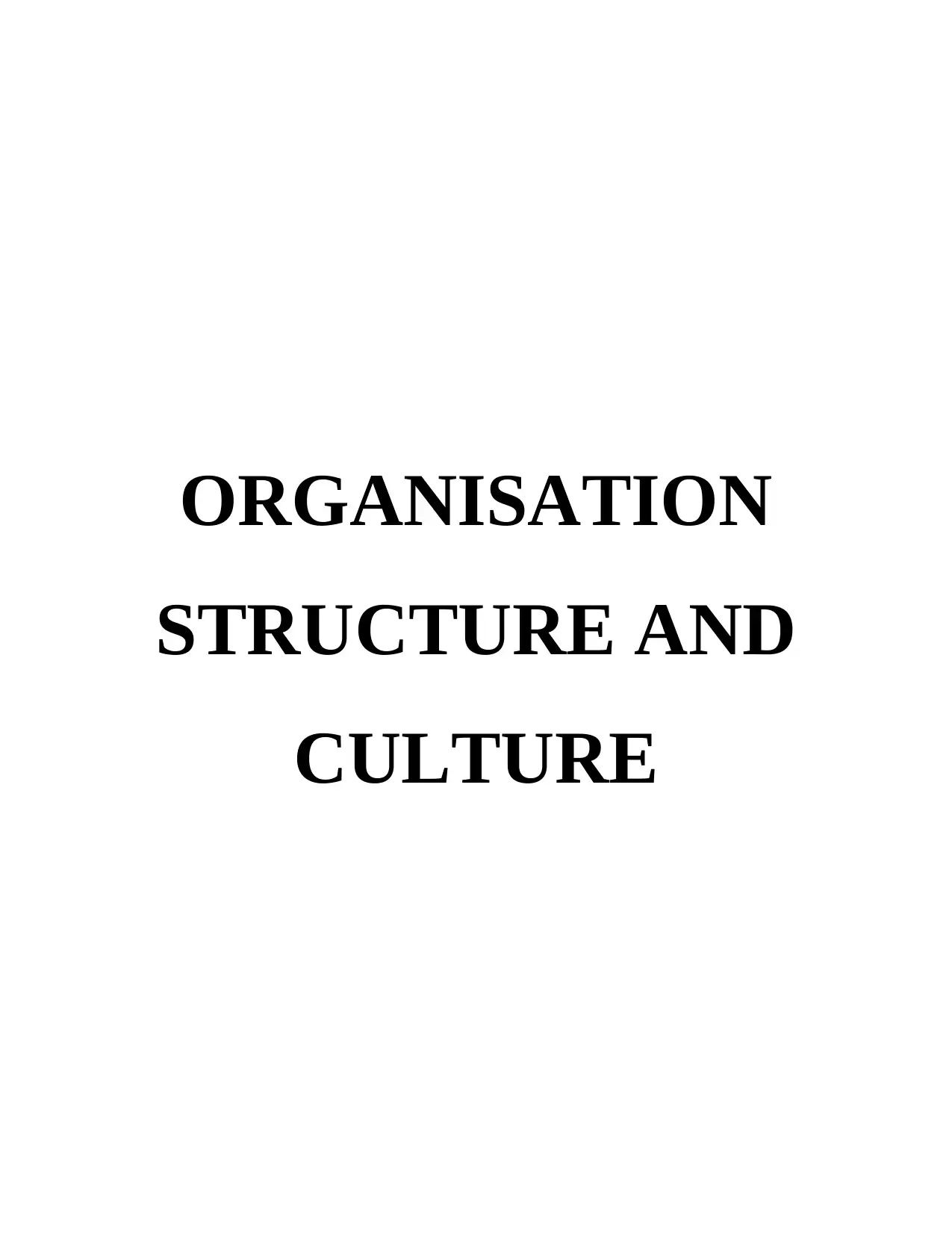
ORGANISATION
STRUCTURE AND
CULTURE
STRUCTURE AND
CULTURE
Paraphrase This Document
Need a fresh take? Get an instant paraphrase of this document with our AI Paraphraser
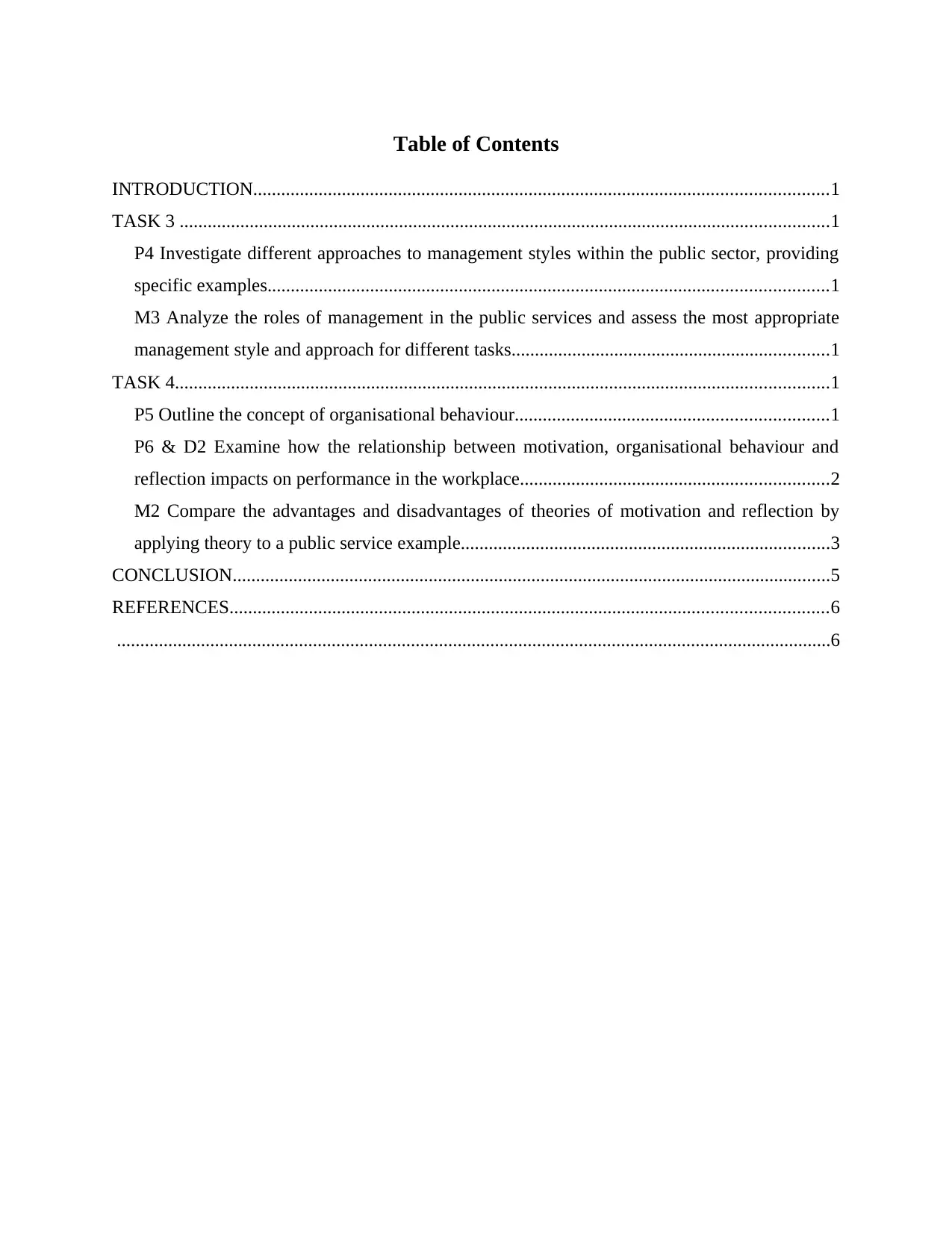
Table of Contents
INTRODUCTION...........................................................................................................................1
TASK 3 ...........................................................................................................................................1
P4 Investigate different approaches to management styles within the public sector, providing
specific examples........................................................................................................................1
M3 Analyze the roles of management in the public services and assess the most appropriate
management style and approach for different tasks....................................................................1
TASK 4............................................................................................................................................1
P5 Outline the concept of organisational behaviour...................................................................1
P6 & D2 Examine how the relationship between motivation, organisational behaviour and
reflection impacts on performance in the workplace..................................................................2
M2 Compare the advantages and disadvantages of theories of motivation and reflection by
applying theory to a public service example...............................................................................3
CONCLUSION................................................................................................................................5
REFERENCES................................................................................................................................6
.........................................................................................................................................................6
INTRODUCTION...........................................................................................................................1
TASK 3 ...........................................................................................................................................1
P4 Investigate different approaches to management styles within the public sector, providing
specific examples........................................................................................................................1
M3 Analyze the roles of management in the public services and assess the most appropriate
management style and approach for different tasks....................................................................1
TASK 4............................................................................................................................................1
P5 Outline the concept of organisational behaviour...................................................................1
P6 & D2 Examine how the relationship between motivation, organisational behaviour and
reflection impacts on performance in the workplace..................................................................2
M2 Compare the advantages and disadvantages of theories of motivation and reflection by
applying theory to a public service example...............................................................................3
CONCLUSION................................................................................................................................5
REFERENCES................................................................................................................................6
.........................................................................................................................................................6
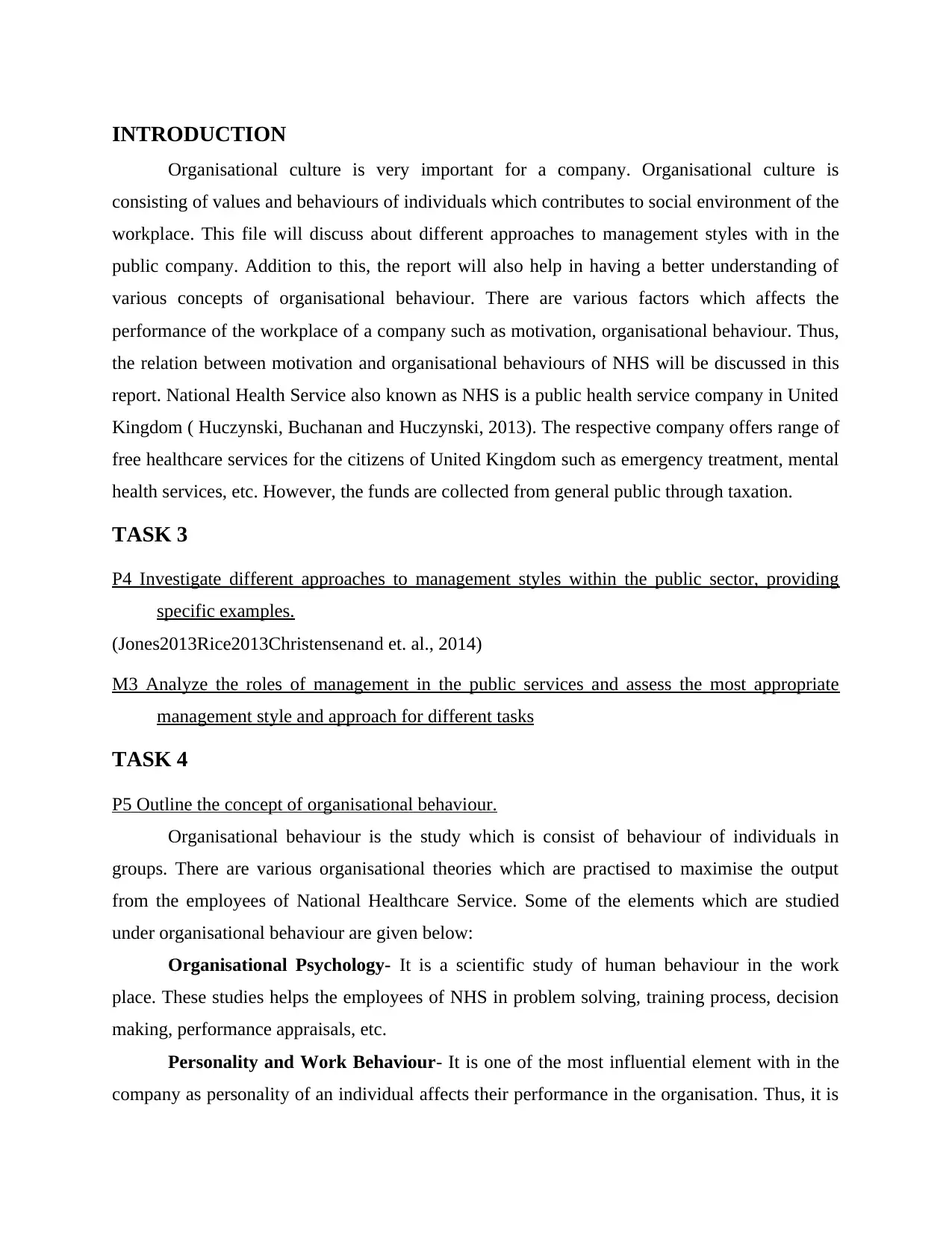
INTRODUCTION
Organisational culture is very important for a company. Organisational culture is
consisting of values and behaviours of individuals which contributes to social environment of the
workplace. This file will discuss about different approaches to management styles with in the
public company. Addition to this, the report will also help in having a better understanding of
various concepts of organisational behaviour. There are various factors which affects the
performance of the workplace of a company such as motivation, organisational behaviour. Thus,
the relation between motivation and organisational behaviours of NHS will be discussed in this
report. National Health Service also known as NHS is a public health service company in United
Kingdom ( Huczynski, Buchanan and Huczynski, 2013). The respective company offers range of
free healthcare services for the citizens of United Kingdom such as emergency treatment, mental
health services, etc. However, the funds are collected from general public through taxation.
TASK 3
P4 Investigate different approaches to management styles within the public sector, providing
specific examples.
(Jones2013Rice2013Christensenand et. al., 2014)
M3 Analyze the roles of management in the public services and assess the most appropriate
management style and approach for different tasks
TASK 4
P5 Outline the concept of organisational behaviour.
Organisational behaviour is the study which is consist of behaviour of individuals in
groups. There are various organisational theories which are practised to maximise the output
from the employees of National Healthcare Service. Some of the elements which are studied
under organisational behaviour are given below:
Organisational Psychology- It is a scientific study of human behaviour in the work
place. These studies helps the employees of NHS in problem solving, training process, decision
making, performance appraisals, etc.
Personality and Work Behaviour- It is one of the most influential element with in the
company as personality of an individual affects their performance in the organisation. Thus, it is
Organisational culture is very important for a company. Organisational culture is
consisting of values and behaviours of individuals which contributes to social environment of the
workplace. This file will discuss about different approaches to management styles with in the
public company. Addition to this, the report will also help in having a better understanding of
various concepts of organisational behaviour. There are various factors which affects the
performance of the workplace of a company such as motivation, organisational behaviour. Thus,
the relation between motivation and organisational behaviours of NHS will be discussed in this
report. National Health Service also known as NHS is a public health service company in United
Kingdom ( Huczynski, Buchanan and Huczynski, 2013). The respective company offers range of
free healthcare services for the citizens of United Kingdom such as emergency treatment, mental
health services, etc. However, the funds are collected from general public through taxation.
TASK 3
P4 Investigate different approaches to management styles within the public sector, providing
specific examples.
(Jones2013Rice2013Christensenand et. al., 2014)
M3 Analyze the roles of management in the public services and assess the most appropriate
management style and approach for different tasks
TASK 4
P5 Outline the concept of organisational behaviour.
Organisational behaviour is the study which is consist of behaviour of individuals in
groups. There are various organisational theories which are practised to maximise the output
from the employees of National Healthcare Service. Some of the elements which are studied
under organisational behaviour are given below:
Organisational Psychology- It is a scientific study of human behaviour in the work
place. These studies helps the employees of NHS in problem solving, training process, decision
making, performance appraisals, etc.
Personality and Work Behaviour- It is one of the most influential element with in the
company as personality of an individual affects their performance in the organisation. Thus, it is
⊘ This is a preview!⊘
Do you want full access?
Subscribe today to unlock all pages.

Trusted by 1+ million students worldwide
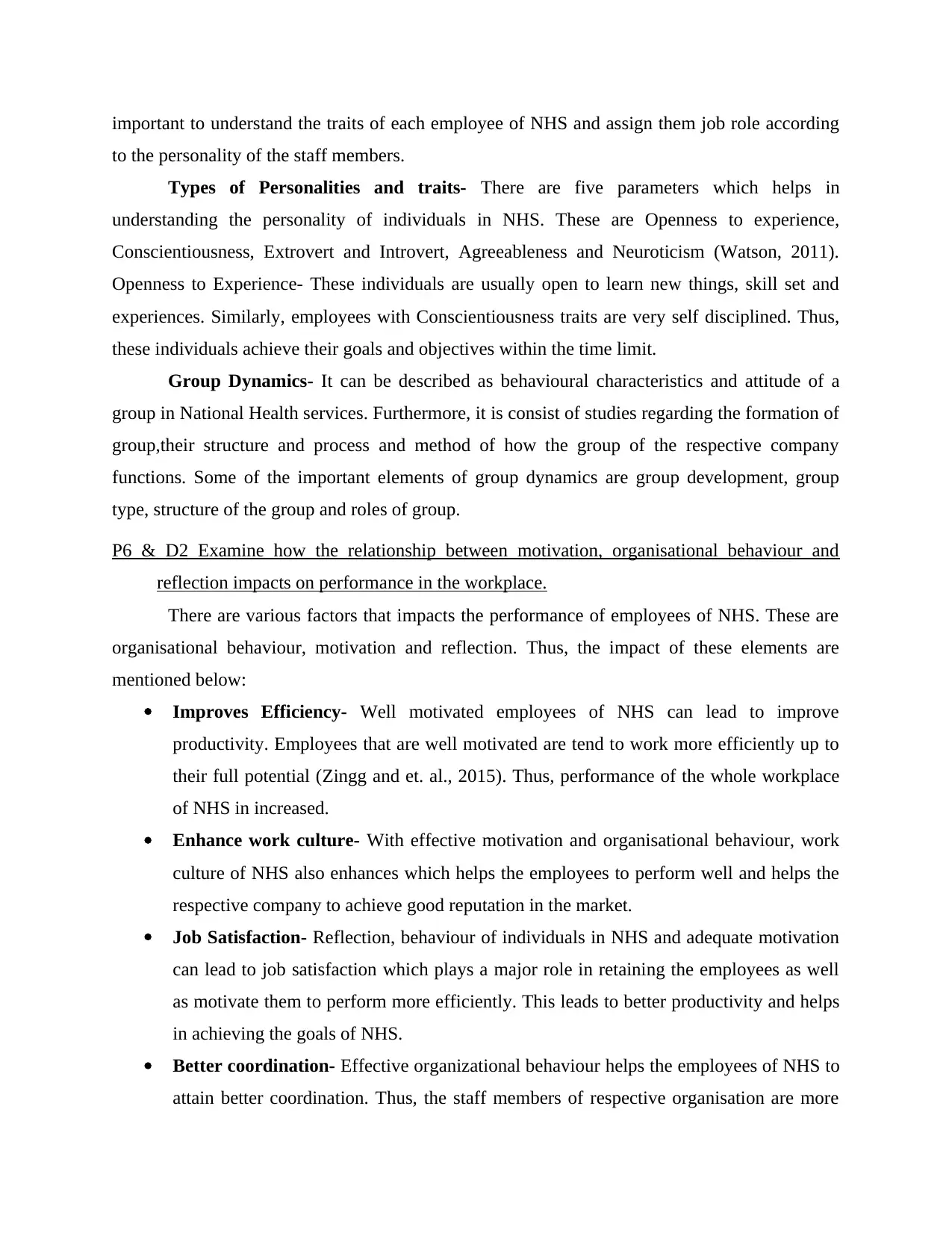
important to understand the traits of each employee of NHS and assign them job role according
to the personality of the staff members.
Types of Personalities and traits- There are five parameters which helps in
understanding the personality of individuals in NHS. These are Openness to experience,
Conscientiousness, Extrovert and Introvert, Agreeableness and Neuroticism (Watson, 2011).
Openness to Experience- These individuals are usually open to learn new things, skill set and
experiences. Similarly, employees with Conscientiousness traits are very self disciplined. Thus,
these individuals achieve their goals and objectives within the time limit.
Group Dynamics- It can be described as behavioural characteristics and attitude of a
group in National Health services. Furthermore, it is consist of studies regarding the formation of
group,their structure and process and method of how the group of the respective company
functions. Some of the important elements of group dynamics are group development, group
type, structure of the group and roles of group.
P6 & D2 Examine how the relationship between motivation, organisational behaviour and
reflection impacts on performance in the workplace.
There are various factors that impacts the performance of employees of NHS. These are
organisational behaviour, motivation and reflection. Thus, the impact of these elements are
mentioned below:
Improves Efficiency- Well motivated employees of NHS can lead to improve
productivity. Employees that are well motivated are tend to work more efficiently up to
their full potential (Zingg and et. al., 2015). Thus, performance of the whole workplace
of NHS in increased.
Enhance work culture- With effective motivation and organisational behaviour, work
culture of NHS also enhances which helps the employees to perform well and helps the
respective company to achieve good reputation in the market.
Job Satisfaction- Reflection, behaviour of individuals in NHS and adequate motivation
can lead to job satisfaction which plays a major role in retaining the employees as well
as motivate them to perform more efficiently. This leads to better productivity and helps
in achieving the goals of NHS.
Better coordination- Effective organizational behaviour helps the employees of NHS to
attain better coordination. Thus, the staff members of respective organisation are more
to the personality of the staff members.
Types of Personalities and traits- There are five parameters which helps in
understanding the personality of individuals in NHS. These are Openness to experience,
Conscientiousness, Extrovert and Introvert, Agreeableness and Neuroticism (Watson, 2011).
Openness to Experience- These individuals are usually open to learn new things, skill set and
experiences. Similarly, employees with Conscientiousness traits are very self disciplined. Thus,
these individuals achieve their goals and objectives within the time limit.
Group Dynamics- It can be described as behavioural characteristics and attitude of a
group in National Health services. Furthermore, it is consist of studies regarding the formation of
group,their structure and process and method of how the group of the respective company
functions. Some of the important elements of group dynamics are group development, group
type, structure of the group and roles of group.
P6 & D2 Examine how the relationship between motivation, organisational behaviour and
reflection impacts on performance in the workplace.
There are various factors that impacts the performance of employees of NHS. These are
organisational behaviour, motivation and reflection. Thus, the impact of these elements are
mentioned below:
Improves Efficiency- Well motivated employees of NHS can lead to improve
productivity. Employees that are well motivated are tend to work more efficiently up to
their full potential (Zingg and et. al., 2015). Thus, performance of the whole workplace
of NHS in increased.
Enhance work culture- With effective motivation and organisational behaviour, work
culture of NHS also enhances which helps the employees to perform well and helps the
respective company to achieve good reputation in the market.
Job Satisfaction- Reflection, behaviour of individuals in NHS and adequate motivation
can lead to job satisfaction which plays a major role in retaining the employees as well
as motivate them to perform more efficiently. This leads to better productivity and helps
in achieving the goals of NHS.
Better coordination- Effective organizational behaviour helps the employees of NHS to
attain better coordination. Thus, the staff members of respective organisation are more
Paraphrase This Document
Need a fresh take? Get an instant paraphrase of this document with our AI Paraphraser
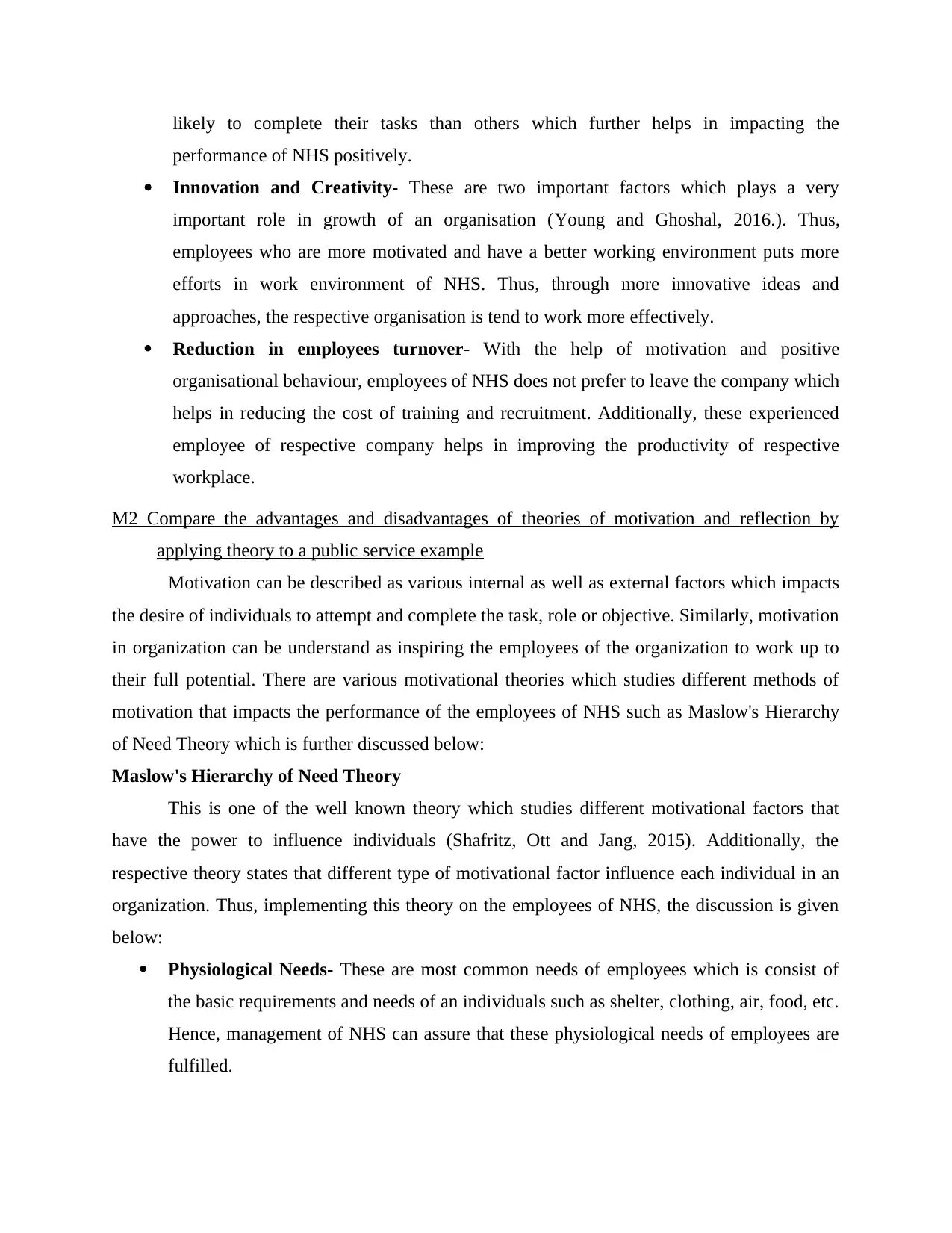
likely to complete their tasks than others which further helps in impacting the
performance of NHS positively.
Innovation and Creativity- These are two important factors which plays a very
important role in growth of an organisation (Young and Ghoshal, 2016.). Thus,
employees who are more motivated and have a better working environment puts more
efforts in work environment of NHS. Thus, through more innovative ideas and
approaches, the respective organisation is tend to work more effectively.
Reduction in employees turnover- With the help of motivation and positive
organisational behaviour, employees of NHS does not prefer to leave the company which
helps in reducing the cost of training and recruitment. Additionally, these experienced
employee of respective company helps in improving the productivity of respective
workplace.
M2 Compare the advantages and disadvantages of theories of motivation and reflection by
applying theory to a public service example
Motivation can be described as various internal as well as external factors which impacts
the desire of individuals to attempt and complete the task, role or objective. Similarly, motivation
in organization can be understand as inspiring the employees of the organization to work up to
their full potential. There are various motivational theories which studies different methods of
motivation that impacts the performance of the employees of NHS such as Maslow's Hierarchy
of Need Theory which is further discussed below:
Maslow's Hierarchy of Need Theory
This is one of the well known theory which studies different motivational factors that
have the power to influence individuals (Shafritz, Ott and Jang, 2015). Additionally, the
respective theory states that different type of motivational factor influence each individual in an
organization. Thus, implementing this theory on the employees of NHS, the discussion is given
below:
Physiological Needs- These are most common needs of employees which is consist of
the basic requirements and needs of an individuals such as shelter, clothing, air, food, etc.
Hence, management of NHS can assure that these physiological needs of employees are
fulfilled.
performance of NHS positively.
Innovation and Creativity- These are two important factors which plays a very
important role in growth of an organisation (Young and Ghoshal, 2016.). Thus,
employees who are more motivated and have a better working environment puts more
efforts in work environment of NHS. Thus, through more innovative ideas and
approaches, the respective organisation is tend to work more effectively.
Reduction in employees turnover- With the help of motivation and positive
organisational behaviour, employees of NHS does not prefer to leave the company which
helps in reducing the cost of training and recruitment. Additionally, these experienced
employee of respective company helps in improving the productivity of respective
workplace.
M2 Compare the advantages and disadvantages of theories of motivation and reflection by
applying theory to a public service example
Motivation can be described as various internal as well as external factors which impacts
the desire of individuals to attempt and complete the task, role or objective. Similarly, motivation
in organization can be understand as inspiring the employees of the organization to work up to
their full potential. There are various motivational theories which studies different methods of
motivation that impacts the performance of the employees of NHS such as Maslow's Hierarchy
of Need Theory which is further discussed below:
Maslow's Hierarchy of Need Theory
This is one of the well known theory which studies different motivational factors that
have the power to influence individuals (Shafritz, Ott and Jang, 2015). Additionally, the
respective theory states that different type of motivational factor influence each individual in an
organization. Thus, implementing this theory on the employees of NHS, the discussion is given
below:
Physiological Needs- These are most common needs of employees which is consist of
the basic requirements and needs of an individuals such as shelter, clothing, air, food, etc.
Hence, management of NHS can assure that these physiological needs of employees are
fulfilled.
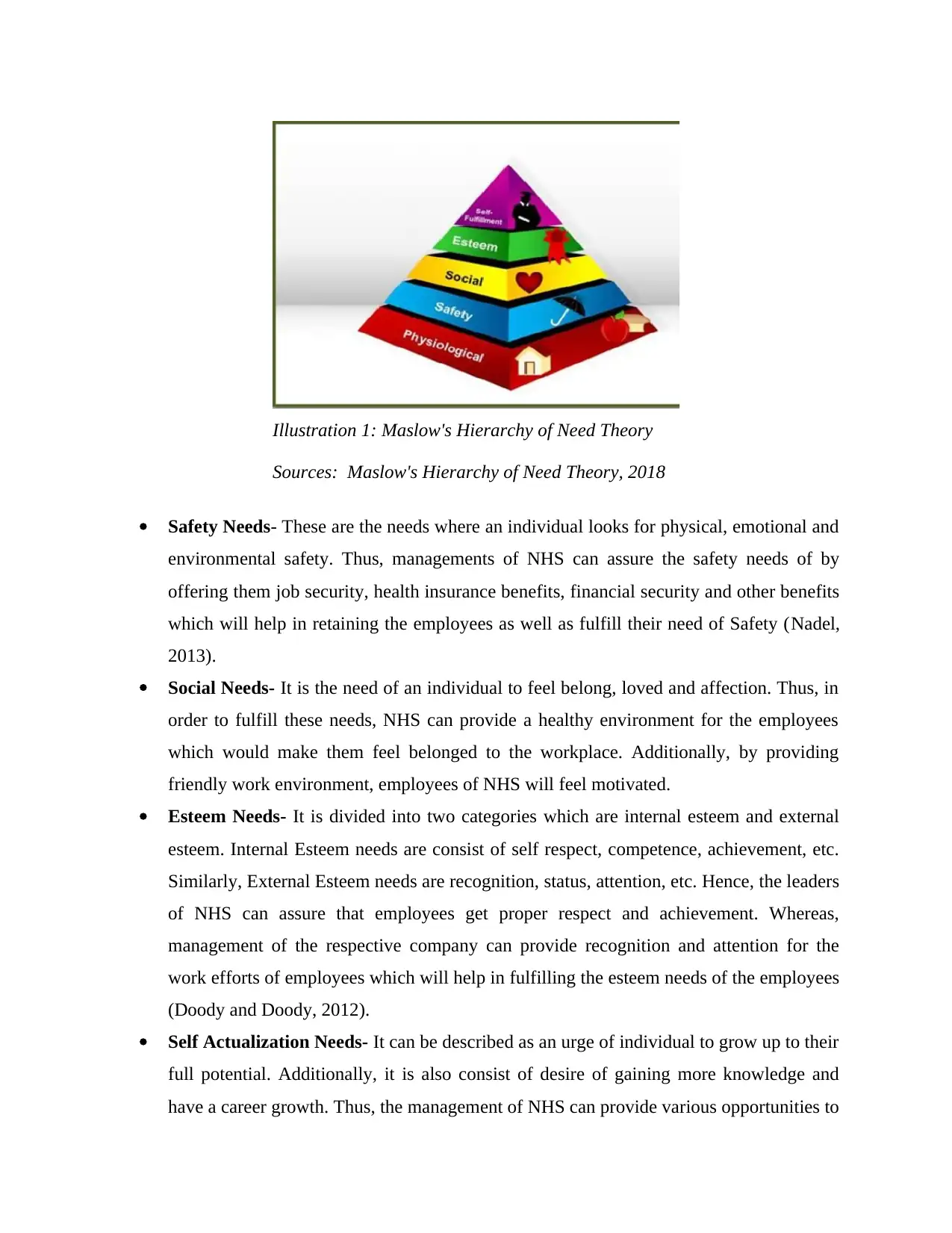
Safety Needs- These are the needs where an individual looks for physical, emotional and
environmental safety. Thus, managements of NHS can assure the safety needs of by
offering them job security, health insurance benefits, financial security and other benefits
which will help in retaining the employees as well as fulfill their need of Safety (Nadel,
2013).
Social Needs- It is the need of an individual to feel belong, loved and affection. Thus, in
order to fulfill these needs, NHS can provide a healthy environment for the employees
which would make them feel belonged to the workplace. Additionally, by providing
friendly work environment, employees of NHS will feel motivated.
Esteem Needs- It is divided into two categories which are internal esteem and external
esteem. Internal Esteem needs are consist of self respect, competence, achievement, etc.
Similarly, External Esteem needs are recognition, status, attention, etc. Hence, the leaders
of NHS can assure that employees get proper respect and achievement. Whereas,
management of the respective company can provide recognition and attention for the
work efforts of employees which will help in fulfilling the esteem needs of the employees
(Doody and Doody, 2012).
Self Actualization Needs- It can be described as an urge of individual to grow up to their
full potential. Additionally, it is also consist of desire of gaining more knowledge and
have a career growth. Thus, the management of NHS can provide various opportunities to
Illustration 1: Maslow's Hierarchy of Need Theory
Sources: Maslow's Hierarchy of Need Theory, 2018
environmental safety. Thus, managements of NHS can assure the safety needs of by
offering them job security, health insurance benefits, financial security and other benefits
which will help in retaining the employees as well as fulfill their need of Safety (Nadel,
2013).
Social Needs- It is the need of an individual to feel belong, loved and affection. Thus, in
order to fulfill these needs, NHS can provide a healthy environment for the employees
which would make them feel belonged to the workplace. Additionally, by providing
friendly work environment, employees of NHS will feel motivated.
Esteem Needs- It is divided into two categories which are internal esteem and external
esteem. Internal Esteem needs are consist of self respect, competence, achievement, etc.
Similarly, External Esteem needs are recognition, status, attention, etc. Hence, the leaders
of NHS can assure that employees get proper respect and achievement. Whereas,
management of the respective company can provide recognition and attention for the
work efforts of employees which will help in fulfilling the esteem needs of the employees
(Doody and Doody, 2012).
Self Actualization Needs- It can be described as an urge of individual to grow up to their
full potential. Additionally, it is also consist of desire of gaining more knowledge and
have a career growth. Thus, the management of NHS can provide various opportunities to
Illustration 1: Maslow's Hierarchy of Need Theory
Sources: Maslow's Hierarchy of Need Theory, 2018
⊘ This is a preview!⊘
Do you want full access?
Subscribe today to unlock all pages.

Trusted by 1+ million students worldwide
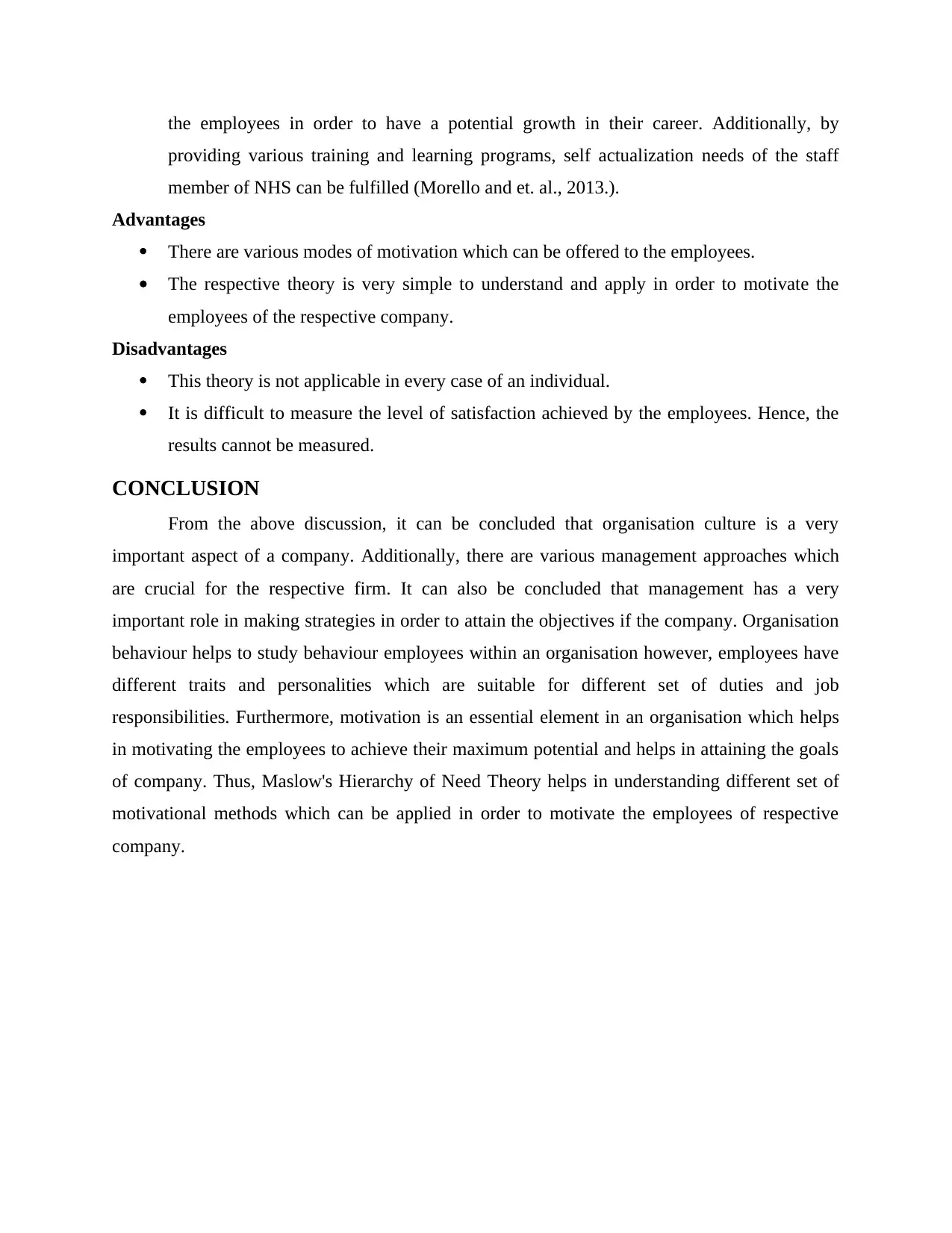
the employees in order to have a potential growth in their career. Additionally, by
providing various training and learning programs, self actualization needs of the staff
member of NHS can be fulfilled (Morello and et. al., 2013.).
Advantages
There are various modes of motivation which can be offered to the employees.
The respective theory is very simple to understand and apply in order to motivate the
employees of the respective company.
Disadvantages
This theory is not applicable in every case of an individual.
It is difficult to measure the level of satisfaction achieved by the employees. Hence, the
results cannot be measured.
CONCLUSION
From the above discussion, it can be concluded that organisation culture is a very
important aspect of a company. Additionally, there are various management approaches which
are crucial for the respective firm. It can also be concluded that management has a very
important role in making strategies in order to attain the objectives if the company. Organisation
behaviour helps to study behaviour employees within an organisation however, employees have
different traits and personalities which are suitable for different set of duties and job
responsibilities. Furthermore, motivation is an essential element in an organisation which helps
in motivating the employees to achieve their maximum potential and helps in attaining the goals
of company. Thus, Maslow's Hierarchy of Need Theory helps in understanding different set of
motivational methods which can be applied in order to motivate the employees of respective
company.
providing various training and learning programs, self actualization needs of the staff
member of NHS can be fulfilled (Morello and et. al., 2013.).
Advantages
There are various modes of motivation which can be offered to the employees.
The respective theory is very simple to understand and apply in order to motivate the
employees of the respective company.
Disadvantages
This theory is not applicable in every case of an individual.
It is difficult to measure the level of satisfaction achieved by the employees. Hence, the
results cannot be measured.
CONCLUSION
From the above discussion, it can be concluded that organisation culture is a very
important aspect of a company. Additionally, there are various management approaches which
are crucial for the respective firm. It can also be concluded that management has a very
important role in making strategies in order to attain the objectives if the company. Organisation
behaviour helps to study behaviour employees within an organisation however, employees have
different traits and personalities which are suitable for different set of duties and job
responsibilities. Furthermore, motivation is an essential element in an organisation which helps
in motivating the employees to achieve their maximum potential and helps in attaining the goals
of company. Thus, Maslow's Hierarchy of Need Theory helps in understanding different set of
motivational methods which can be applied in order to motivate the employees of respective
company.
Paraphrase This Document
Need a fresh take? Get an instant paraphrase of this document with our AI Paraphraser
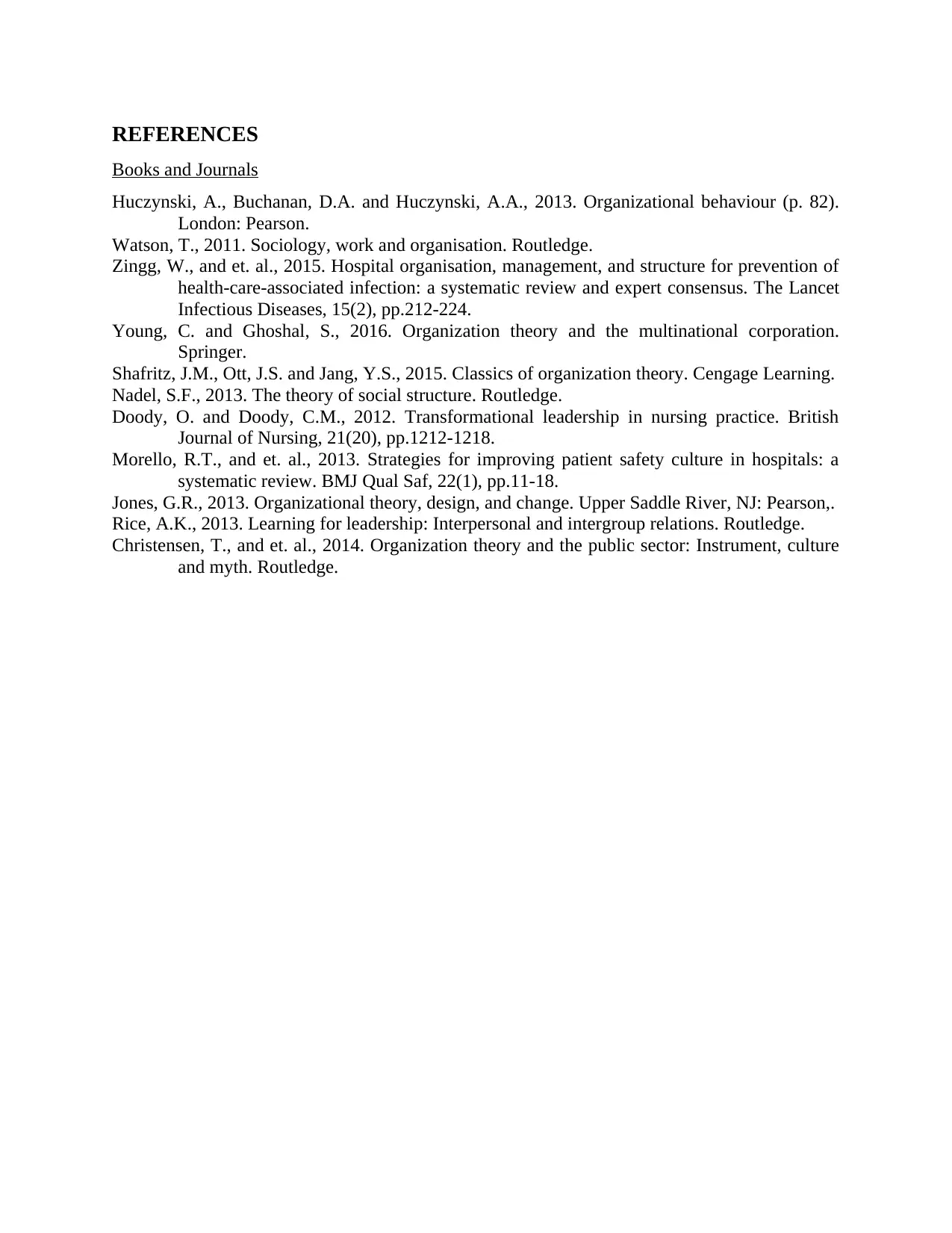
REFERENCES
Books and Journals
Huczynski, A., Buchanan, D.A. and Huczynski, A.A., 2013. Organizational behaviour (p. 82).
London: Pearson.
Watson, T., 2011. Sociology, work and organisation. Routledge.
Zingg, W., and et. al., 2015. Hospital organisation, management, and structure for prevention of
health-care-associated infection: a systematic review and expert consensus. The Lancet
Infectious Diseases, 15(2), pp.212-224.
Young, C. and Ghoshal, S., 2016. Organization theory and the multinational corporation.
Springer.
Shafritz, J.M., Ott, J.S. and Jang, Y.S., 2015. Classics of organization theory. Cengage Learning.
Nadel, S.F., 2013. The theory of social structure. Routledge.
Doody, O. and Doody, C.M., 2012. Transformational leadership in nursing practice. British
Journal of Nursing, 21(20), pp.1212-1218.
Morello, R.T., and et. al., 2013. Strategies for improving patient safety culture in hospitals: a
systematic review. BMJ Qual Saf, 22(1), pp.11-18.
Jones, G.R., 2013. Organizational theory, design, and change. Upper Saddle River, NJ: Pearson,.
Rice, A.K., 2013. Learning for leadership: Interpersonal and intergroup relations. Routledge.
Christensen, T., and et. al., 2014. Organization theory and the public sector: Instrument, culture
and myth. Routledge.
Books and Journals
Huczynski, A., Buchanan, D.A. and Huczynski, A.A., 2013. Organizational behaviour (p. 82).
London: Pearson.
Watson, T., 2011. Sociology, work and organisation. Routledge.
Zingg, W., and et. al., 2015. Hospital organisation, management, and structure for prevention of
health-care-associated infection: a systematic review and expert consensus. The Lancet
Infectious Diseases, 15(2), pp.212-224.
Young, C. and Ghoshal, S., 2016. Organization theory and the multinational corporation.
Springer.
Shafritz, J.M., Ott, J.S. and Jang, Y.S., 2015. Classics of organization theory. Cengage Learning.
Nadel, S.F., 2013. The theory of social structure. Routledge.
Doody, O. and Doody, C.M., 2012. Transformational leadership in nursing practice. British
Journal of Nursing, 21(20), pp.1212-1218.
Morello, R.T., and et. al., 2013. Strategies for improving patient safety culture in hospitals: a
systematic review. BMJ Qual Saf, 22(1), pp.11-18.
Jones, G.R., 2013. Organizational theory, design, and change. Upper Saddle River, NJ: Pearson,.
Rice, A.K., 2013. Learning for leadership: Interpersonal and intergroup relations. Routledge.
Christensen, T., and et. al., 2014. Organization theory and the public sector: Instrument, culture
and myth. Routledge.
1 out of 8
Related Documents
Your All-in-One AI-Powered Toolkit for Academic Success.
+13062052269
info@desklib.com
Available 24*7 on WhatsApp / Email
![[object Object]](/_next/static/media/star-bottom.7253800d.svg)
Unlock your academic potential
Copyright © 2020–2025 A2Z Services. All Rights Reserved. Developed and managed by ZUCOL.





